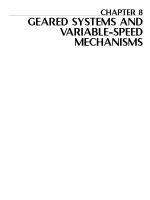Literary devices powerpoint
Bạn đang xem bản rút gọn của tài liệu. Xem và tải ngay bản đầy đủ của tài liệu tại đây (273.65 KB, 39 trang )
Literary Terms
We will be using these literary terms
throughout the school year.
There WILL be literary terms used on
your FINAL EXAMS in May!!
You need to keep up with your notes.
Don’t lose your terms! You might be
able to use them –
be RESPONSIBLE!!
We will use the following terms:
Character
Diction
Imagery
Exposition
Falling Action
Flashback
Point of View
Theme
Metaphor
Personification
Antagonist
Denotation
Mood
Rising Action
Resolution
Foreshadowing
Setting
Tone
Simile
Alliteration
Protagonist
Connotation
Plot
Climax
Conflict
Suspense
Style
Figures of Speech
Oxymoron
Character
A character is a person or
an animal that takes part
in the action of a literary
work.
Antagonist
•The Antagonist is a
character or force in conflict
with a main character, or
protagonist.
Do you know your Antagonists???
• On your paper take a few minutes to write
down some Antagonists that you can
recall from movies, television shows, and
video games
• Remember the Antagonist is in conflict
with the Protagonist or, main character!
• Helpful hint – you should now know why
people use the saying “Don’t antagonize
me!”
Protagonist
• The Protagonist is the main
character in a literary work
• Can you name some famous
Protagonists that are found in
literature?
Diction
• Diction is the manner in which
•
•
we express words; the wording
used.
Diction = enunciation
Some easy examples are:
Don’t say ‘goin’ – say ‘going’, Don’t say ‘wanna’ – say ‘want to’
Denotation
The denotation of a word
is its dictionary meaning,
independent of other
associations that the
word may have.
Connotation
The connotation of a word is the set of
ideas associated with it in addition to
its explicit meaning. The connotation
of a word can be personal, based on
individual experiences. More often,
cultural connotations – those
recognizable by most people in a
group – determine a writer’s word
choices.
Denotation versus Connotation
Some examples –
Cheap is “low in cost” (denotation) but
“stingy” or “poorly made” are the
connotations of cheap
Let’s use the word HOT
The denotation (or dictionary definition – remember d in denotation =
dictionary) of HOT is: having a temperature higher
than that of a human body.
However, when you say “Man! He/She is hot!”,
are you saying “Man! He is having a
temperature higher than that of a human
body!”? No!!
You are saying the CONNOTATION of HOT – which
could mean a variety of things – man he/she is
cute, attractive, beautiful, and many other
meanings – those come from personal
experiences and cultural meanings, etc.
Imagery
Imagery is words or phrases
that appeal to one or more of
the five senses. Writers use
imagery to describe how their
subjects look, sound, feel,
taste, and smell.
MOOD
Mood, or atmosphere, is the feeling
created in the reader by a literary
work or passage. Writer’s use many
devices to create mood, including
images, dialogue, setting, and plot.
Often, a writer creates a mood at the
beginning of a work and then
sustains the mood throughout.
Sometimes, however, the mood of
the work changes dramatically.
Plot
Plot is the sequence of events. The first event
causes the second, the second causes the third,
and so forth.
In most novels, dramas, short stories, and narrative
poems, the plot involves both characters and a
central conflict.
The plot usually begins with an exposition that
introduces the setting, the characters, and the
basic situation. This is introduced and developed.
The conflict then increases until it reaches a high
point of interest or suspense, the climax. The
climax is followed by the falling action, or end, of
the central conflict. Any events that occur during
the falling action make up the resolution.
PLOTLINE
Exposition
Conflict Introduced
n
tio
Ac
Risi
ng
ing
A ct
ll
Fa
ion
Climax
Resolution
Exposition
The Exposition is the
introduction. It is the part
of the work that introduces
the characters, setting, and
basic situation.
Rising Action
Rising Action is the part of the
plot that begins to occur as
soon as the conflict is
introduced. The rising action
adds complications to the
conflict and increases reader
interest.
Climax
The Climax is the point of
greatest emotional intensity,
interest, or suspense in the
plot of a narrative. The climax
typically comes at the turning
point in a story or drama.
Falling Action
Falling Action is the action that
typically follows the climax and
reveals its results.
Resolution
The Resolution is the part of
the plot that concludes the
falling action by revealing or
suggesting the outcome of
the conflict.
Conflict
Conflict is the struggle
between opposing forces in
a story or play. There are
two types of conflict that
exist in literature.
External Conflict
External conflict exists when a character
struggles against some outside force, such
as another character, nature, society, or
fate.
Man vs. Man
Man vs. Nature
Internal Conflict
Internal conflict exists within the mind of a
character who is torn between different
courses of action.
Man vs. Himself
Flashback
A flashback is a literary device in
which an earlier episode,
conversation, or event is inserted
into the sequence of events.
Often flashbacks are presented as
a memory of the narrator or of
another character.
Flashback continued…
The movie Titanic is told almost entirely in a
flashback.
What are some other films that contain
flashback to help tell stories?
Holes
Willy Wonka
Think of some more…









